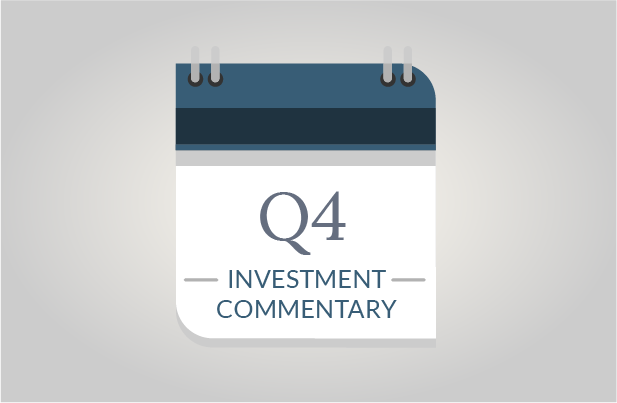- Stocks incurred their worst declines since 2008 and bonds suffered their heaviest losses in more than 100 years.
- Many decades-long investment trends reversed in 2022, reminding investors that investments always move in cycles.
- The rate of inflation remained high during 2022 but finally began to ease in the fourth quarter.
A Difficult Year for Investors
The growth of the U.S. economy pulled back some during 2022, but the impact to investments was far greater. Stocks and bonds were battered, both ending the year down by double-digits. Losses extended both domestically and internationally. It was the worst year for stocks since the Great Recession in 2008, and the worst year for bonds in modern history. Trillions of investment dollars were lost in 2022 due to a swath of factors. Persistently high global inflation, the war in Ukraine, and extended zero-Covid lockdowns in China whipsawed investments, currencies, and commodities. There were few places to hide from investment losses given the breadth of market impact. A summary of 2022 broad market performance as of year-end is as follows:
- Bloomberg U.S. Aggregate (U.S. bonds) -13.0%
- S&P 500 Index (large U.S. stocks) -18.1%
- Nasdaq (largely tech & growth stocks) -32.5%
- Russell 2000 (small U.S. stocks) -20.4%
- MSCI All Country World Index ex-US -16.0%
(International Stocks)
Significant Market Reversals in 2022
One of our core investment philosophies is to not try to time the market. Historically, the best investment sectors can suddenly become the worst investment sectors, and no one sector stays the top performer forever. Last year was a distinct example of this.
The Technology Darlings Became Duds:
For the past decade, technology stocks have soared in performance, far outpacing more dividend-focused value stocks. Facebook, Amazon, Apple, Netflix and Google, the so-called FAANG stocks, have dominated the U.S. stock market for years. However, inflation brought future growth expectations (a critical factor in technology stock pricing) into question. While the S&P 500 Index’s performance was -18.1%, the FAANG stocks suffered far heavier losses as follows: Facebook -64%, Amazon -49%, Apple -26%, Netflix -51%, and Google -39%. Tesla also suffered a hefty loss of -65%.
Value Investing Came Back in Vogue:
As technology stocks fell out of favor, value came back in vogue, largely due to dividends creating more guaranteed current cash flow. This disrupted the long-run notion that value investing was dead. Outperformance in energy stocks, largely resulting from the war in Ukraine, helped to bolster value stock performance, but value stocks as a whole, among various industries, experienced higher relative performance.
International Stocks Outpaced Domestic Stocks:
International stocks, which have underperformed in recent years, also staged a comeback relative to domestic stocks. International stocks were down in 2022, but their losses were less severe compared to domestic stocks. The reason is largely attributable to high dividend yields, similar to the attraction to more value-oriented stocks. Also worthy of note, is the significant downfall of crypto securities. Bitcoin fell 64.8% while both BlockFi and FTX experienced full bankruptcies. We have fully avoided cryptocurrencies in our investment portfolios.
Bonds
Outside of the stock market, bonds endured their worst year in more than a century. U.S. interest rates skyrocketed as the Federal Reserve Board (Fed) raised rates in an effort to combat inflation. Bonds are typically owned for two primary reasons: income and preservation. The preservation attribute of bonds fell apart in 2022. It is not uncommon for clients to ask if there is hope for stocks during market downturns. History has shown that stocks have recovered from each prior downturn, of which there have been many. Some are now questioning the hope for bonds given the depth of price declines in 2022. While we can never offer guarantees, we do see a brighter path for bonds in the future. Interest rate increases will eventually subside. Furthermore, bond performance can improve before the Fed stops raising rates. We saw this post the last rate increase. Critically important is the fact that today’s higher interest environment means that bonds are paying higher income yields. That income is becoming more attractive as bonds pay hard cash, the same allure that has made value stocks more attractive of late. When bonds pay higher interest rates, they become stronger investment competitors to stocks. As such, a bright horizon could lay ahead for the bond market.
Inflation
Inflation has been a primary obstacle for both stocks and bonds. Soaring prices eroded financial conditions. The inflation rate hit a high of over 9% in June but has since subsided to a pace of 7.1%. No one can predict where inflation is headed. However, there are three positive points to note.
- The Fed has expressed clear intentions to remain vigilant until inflation is brought under control.
- We have already seen improvement as the pace of inflation has declined.
- Several indicators suggest further progress in that direction, such as the pace of wage increases, declining energy costs, a slowing housing market and other data points.
We believe it is important to recognize that while high inflation has negatively impacted stocks and bonds, lower inflation results could easily lift stock and bond prices into recovery.
A Slowing Housing Market – An Inflation Cure?
Developments in the housing market could play a significant role in the trajectory of inflation. Home prices are under pressure after their largest price ascent in history. Prices have fallen for at least ten straight months, and the volume of purchases fell 30% in the third quarter alone. Declines are largely due to rising mortgage rates. Mortgage rates doubled in 2022, recording their largest increase in any calendar year. A softening housing market could materially stunt inflation given the significant ripple effect that housing has throughout the economy. Housing affects lumber, materials, labor, appliances, furnishings, electronics, and much more. While home prices are declining, the ultimate reflection of declines in Consumer Price Index (CPI) figures could be delayed. This is because CPI housing figures are based upon rental prices, which take months for lease terms to turnover. While sector declines are never enjoyable, we do think that today’s contraction in housing could be a pivotal point for inflation to ebb.
Our Approach
SageVest made several investment repositioning efforts in 2022 such as restructuring bonds, buying on market dips, changes in our small-cap stock holdings, and investment tax moves to enhance long-term after-tax returns. We remain committed to enacting investment changes as appropriate relative to your financial needs and goals going into 2023. These are often identified as part of planning efforts under our total wealth management approach. We firmly believe in proactive planning and likewise welcome you to contact us at any time. SageVest Wealth Management




